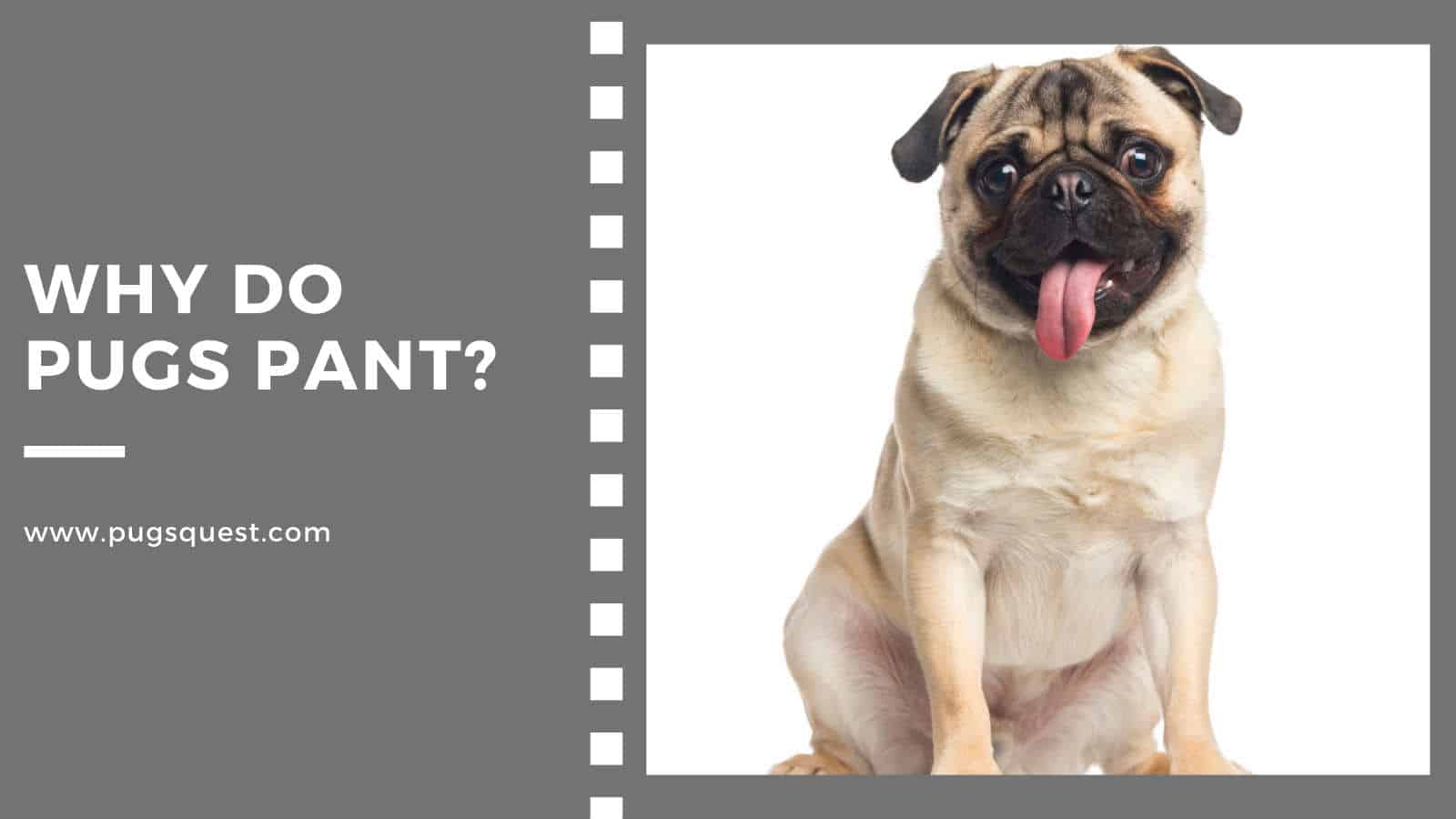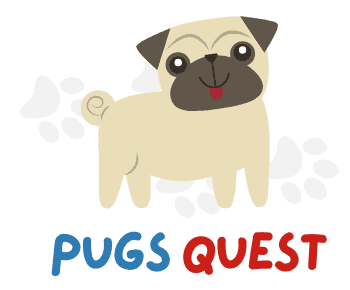
Whilst moderate panting is completely normal canine behavior, excessive panting can be a sign of illness or discomfort.
But fear not. We’re going to be discussing everything you need to know about panting Pugs. Why do pugs pant, what’s normal or not, and everything in between.
Shall we get started?
Why Do Pugs Pant?
Dogs make lots of different noises from day today. They gulp, snore, sneeze, and pant.
All dogs pant from time to time. And in most cases, it’s perfectly normal. Perhaps your pup is excited about something or regulating its temperature on a hot summer’s day.
But for Pug owners, panting is a behavior to assess with added caution. Brachycephalic dogs like Pugs and other flat-nosed breeds can have trouble breathing. And these breathing problems can often correlate with excessive panting.
Brachycephaly is a genetic predisposition that results in an obstruction of the upper airway. This makes it difficult for some Pugs to breathe and makes them extra vulnerable to extremes of temperature.
Check out this video all about Brachycephalic airway syndrome:
Panting serves an absolutely imperative physiological function. It is your Pug’s primary temperature regulation tool. When dogs pant, they circulate air throughout their bodies. In other words, panting serves a similar function to sweating in humans – it helps us keep cool.
Dogs do not have sweat glands. Instead, when your Pug pants, moisture evaporates from their mouth and tongue, and cool air is circulated throughout their body.
Pugs Panting: What’s Normal and What’s Not?
So what’s normal and what’s not when it comes to panting?
This is a common question that most Pug parents will encounter at one time or another.
Pugs pant, on average, more frequently and more intensely than other dog breeds. And that means it can sometimes be difficult to differentiate between what’s normal and what’s cause for serious concern.
As a general rule, normal panting is panting that serves an obvious function. For example, if it is a hot day you might expect your Pug to pant more than usual. This is their way of cooling down and regulating their breathing motions.
Please note: in extreme temperatures your Pug might have trouble regulating their body heat with panting alone. If their panting continues relentlessly, it’s time to step in. Take the inside into a temperature-regulated environment and provide plenty of water for hydration.
In contrast, abnormal panting is panting that occurs for no obvious reason. Abnormal panting behavior might appear louder, harsher, or more excessive than normal panting behavior.
This could be a sign of an underlying health condition and warrants a trip to the vet. If your Pug seems to be struggling to breathe visit your veterinarian immediately.
Common Pug Panting Triggers
There are many physiological and health stimuli that might cause your pet to start panting more than usual. Let’s take a look at some of the most common Pug panting triggers.
1. Trying to cool down
This is the most common trigger for panting. Panting is completely normal after a period of exercise or on a particularly hot summer day.
Just like us, your Pug will get very warm when they are physically active or when the sun is blaring.
And, as we’ve already mentioned, Pugs do not have sweat glands. Instead, they cool down through panting.
This is usually nothing to worry about, but it’s always best to provide your Pug with an opportunity to cool down in a temperature-regulated environment.
2. Heatstroke
If your Pug becomes overheated, they are at great risk of heatstroke. This is no laughing matter. Heatstroke is a potentially fatal condition.
If you suspect your Pug is suffering from heatstroke take immediate action. Return them to a cooler environment until they regain normal breathing, provide water, and get a veterinary checkup as soon as possible.
Signs of heatstroke include:
- Excessive drooling
- Vomiting
- Lack of coordination
- Panting
- Weakness
- Loss of consciousness.
3. BOAS
BOAS stands for Brachycephalic Obstructive Airway Syndrome. We now know that Pugs are a Brachycephalic breed but what does this really mean?
Pugs and other brachycephalic friends are known for their squished, flat faces. But this aesthetic comes at a price – and that price is breathing.
The condition is characterized by:
- An elongated soft palate – this interfered with the movement of air in the lungs
- Everted laryngeal saccules – this obstructs normal airflow
- Stenotic nares – narrow nostrils make breathing via the nose difficult
Pugs are genetically predisposed to BOAS, and it is therefore imperative that Pug owners take extra care of their pup’s breathing.
4. Stress & anxiety
Sometimes, panting may be a behavioral response to stress or feelings of anxiety. A bit like a panic attack in humans.
If your Pug’s health and environment are otherwise in good order, then any unusual panting is likely to be a stress response. Look out for changes in your Pug’s behavior.
If they are trembling, licking the air, whining, extra clingy, or reclusive, chances are they are feeling anxious.
Ask yourself what might be causing this behavior (fireworks or guests in the house are typical examples). Failing that it’s worth visiting your vet to try and get to the root of your pet’s stress.
5. Pain or discomfort
Dogs don’t express pain as we do. Night panting is a tell-tale sign that your pet is suffering physically. This is their way of moderating their pain.
Look out for other signs such as limping, appetite, mood, or behavioral abnormalities. These are all signs that your Pug is in pain. It’s time to call up the vet.
6. Allergies or poisoning
Panting can sometimes be a response to allergies. It might also occur if your Pug has ingested something they shouldn’t have.
Things like dangerous plants, chemicals, rat poison, or even chocolate, can do real damage to your Pug.
Likewise, sometimes animals will react poorly to new medications or foods. Panting is a natural response to these situations and it’s important to visit your vet immediately.
7. Health-related causes
In some cases, there may be a health condition causing your Pug’s panting behavior. It’s important to be aware of these conditions and visit your vet if you notice any excessive or abnormal panting.
Health conditions that cause panting include:
- Heart failure
Heart failure occurs when the body fails to pump blood and oxygen around the body. Signs of heart failure include weakness, coughing, panting, and aversion to exercise.
- Anemia
Anemia refers to a low red blood cell count. Anemia leads to oxygen deprivation which often shows up as panting.
- Obesity
Obesity can make it even harder for brachycephalic dogs to breathe properly. Excessive panting means that your Pug is struggling to breathe.
- Cushing’s disease
Cushing’s disease affects the adrenal glands – which produce too much cortisol causing excessive panting, urination, and increased appetite in dogs.
Preventative Measures to Help Pug Panting at Home
For mild or moderate cases of panting, there are plenty of things you can do at home or out and about to help your Pug ease their breathing back into a healthy rhythm.
Take a look at some of our favorite DIY top tips that will help your pooch breathe easy all year round.
1. Avoid allergens
As much as possible, try to protect your Pug from allergens. Anything from smoke, to fleas, dust mites, certain trees, pollens, and grasses are potential allergens.
If you know (or suspect) that your Pug has an allergic sensitivity to something, try to limit contact with it.
2. Keep exercise moderate
Pugs are not Olympic athletes. They’re not built for strenuous exercise.
One of the best things you can do to help your Pug’s breathing is to avoid over-exercising or overstimulating them. Especially in extreme temperatures.
3. Hydrate
Carry water with you wherever you go. If your Pug is overheating they’ll need to hydrate.
But more importantly, keeping hydrated on walks or trips to the park is a great way to prevent overheating in the first place.
4. Use a harness
Never use a classic lead with your Pug. This setup will only hamper their breathing even further.
You’ll want to invest in a comfy and supportive dog harness instead. Harnesses distribute weight more evenly and prevent unnecessary stress to the neck and throat.
5. Avoid the hottest hours
Never go for walkies in peak heat or peak cold. This is a recipe for disaster in any Pug household. Instead, choose the mildest times of day for your daily exercise.
Early morning or early evening are usually the best, but obviously, this will depend on the climate in your area.
Pugs Panting – One To Look Out For
When it comes to Brachycephalic breeds like Pugs, panting is something to pay close attention to.
Though in most cases, panting is a perfectly normal canine behavior, it can also be a sign that your Pug is struggling to breathe.
Now you know exactly what to look out for you can monitor your Pug’s panting like a pro.
Remember, if in doubt, visit your vet.
